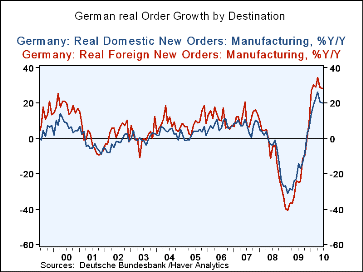 Global| Aug 05 2010
Global| Aug 05 2010German Orders Soar On Overseas Demand....Domestic Orders Just Sore
Summary
German growth in orders continues to be lead by foreign demand. Despite a surge in orders in June the Yr/Yr pace in overall orders is stepping down from its highest pace of several months ago. Over 12-months foreign orders are up by [...]
 German growth in orders continues to be lead by foreign demand. Despite a surge in orders in June the Yr/Yr pace in overall orders is stepping down from its highest pace of several months ago. Over 12-months foreign orders are up by 28% compared to a gain of 20% for domestic orders. Over three months, however, the pace of foreign order growth is 45.5% compared to 11.5% for domestic orders.
German growth in orders continues to be lead by foreign demand. Despite a surge in orders in June the Yr/Yr pace in overall orders is stepping down from its highest pace of several months ago. Over 12-months foreign orders are up by 28% compared to a gain of 20% for domestic orders. Over three months, however, the pace of foreign order growth is 45.5% compared to 11.5% for domestic orders.
Export sales climbed by 5.7 percent in June, driven by an 11.3 percent gain in orders from the euro area alone. Domestic orders rose by just 0.3 percent as the domestic economy still fails to click. Investment goods orders jumped 6.4 percent and consumer goods orders advanced 0.9 percent. Basic goods orders fell 0.8 percent.
Sales trends show some strength in consumer durables but weakness for consumer demand overall. The strength in sales is still in investment goods and in intermediate goods.
With the June report in, second quarter data are complete even if not fully revised. The picture shows strength in foreign and domestic orders in the quarter with foreign orders rising at a 41% pace and domestic orders advancing at a 25% pace. Real sector sales are up at a 6% pace for consumer goods, 23% for capital goods and 26% for intermediate goods. For Germany it was a hot quarter for the manufacturing sector.
| German Orders and Sales By Sector and Origin | ||||||||
|---|---|---|---|---|---|---|---|---|
| Real and SA | % M/M | % Saar | ||||||
| Jun-10 | May-10 | Apr-10 | 3-Mo | 6-Mo | 12-Mo | YrAgo | QTR-2- Date |
|
| Total Orders | 3.2% | -0.1% | 3.3% | 28.9% | 13.5% | 24.5% | -23.5% | 34.2% |
| Foreign | 5.7% | 0.3% | 3.6% | 45.5% | 20.6% | 28.1% | -24.1% | 41.7% |
| Domestic | 0.3% | -0.5% | 3.0% | 11.5% | 5.6% | 20.2% | -22.8% | 25.7% |
| Real Sector Sales | ||||||||
| MFG/Mining | -0.3% | 3.1% | 1.3% | 17.9% | 8.6% | 10.5% | -17.8% | 22.2% |
| Consumer | 0.0% | 1.3% | -0.9% | 1.3% | 0.6% | 1.7% | -7.2% | 6.2% |
| Cons Durables | -0.6% | 5.6% | 1.3% | 28.1% | 13.2% | 11.2% | -21.4% | 14.4% |
| Cons Non-Durable | 0.1% | 0.6% | -1.3% | -2.5% | -1.2% | 0.3% | -4.5% | 5.2% |
| Captial Gds | -0.6% | 5.2% | 0.0% | 19.8% | 9.5% | 11.4% | -22.4% | 23.4% |
| Intermediate Gds | -0.6% | 1.6% | 3.4% | 18.5% | 8.9% | 14.7% | -18.7% | 26.2% |
| All MFG-Sales | -0.3% | 3.2% | 1.3% | 18.3% | 8.8% | 10.6% | -17.7% | 22.5% |
Robert Brusca
AuthorMore in Author Profile »Robert A. Brusca is Chief Economist of Fact and Opinion Economics, a consulting firm he founded in Manhattan. He has been an economist on Wall Street for over 25 years. He has visited central banking and large institutional clients in over 30 countries in his career as an economist. Mr. Brusca was a Divisional Research Chief at the Federal Reserve Bank of NY (Chief of the International Financial markets Division), a Fed Watcher at Irving Trust and Chief Economist at Nikko Securities International. He is widely quoted and appears in various media. Mr. Brusca holds an MA and Ph.D. in economics from Michigan State University and a BA in Economics from the University of Michigan. His research pursues his strong interests in non aligned policy economics as well as international economics. FAO Economics’ research targets investors to assist them in making better investment decisions in stocks, bonds and in a variety of international assets. The company does not manage money and has no conflicts in giving economic advice.






